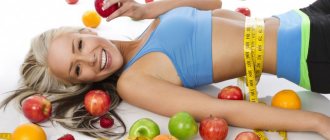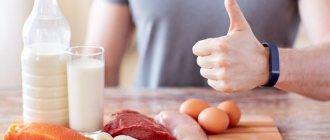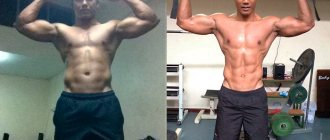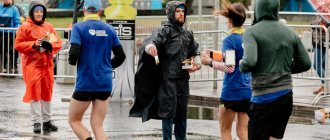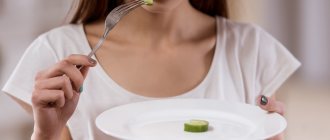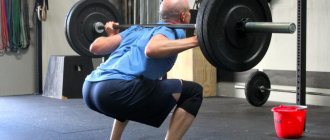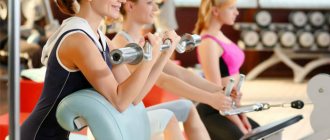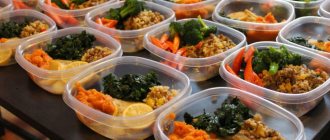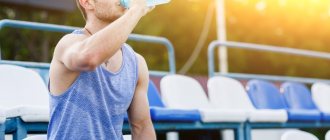Experts:
Stanley A. Herring, MD, W. Ben Kibler, MD, Lexington, Y Margot Putukian, MD, NJ Stephen O_Brien, MD, Rebecca Jaffe, MD, Lori Boyajian-O_Neill, DO, Vincent Disabella, DO, R. Robert Franks, DO, Voorhees, NJ Michele LaBotz, MD
Consultant
— Jacqueline Berning.
Translation
Sergei Strukov.
Sports nutrition
– providing essential nutrients, including fluids, for energy for training, competition, recovery, and health and wellness. The intake and expenditure of these nutrients will be called energy balance. Optimal performance is ensured by adequate energy consumption.
The purpose of this information is to help sports team physicians understand specific nutritional issues in order to advise athletes regarding health and optimal performance.
This is an overview of selected medical issues that are of importance to team physicians responsible for the medical care and treatment of athletes. It is not a standard of care and should not be considered as such. This document is only a guide of a general nature for thoughtful, objective health care practice. Adequate insurance must be in place to protect doctors, athletes and sponsoring organizations.
The recommendations were developed in collaboration with six major specialized sports medicine organizations:
- American Academy of Family Physicians,
- American Academy of Orthopedic Surgeons,
- American College of Sports Medicine,
- American Medical Society for Sports Medicine,
- American Orthopedic Society for Sports Medicine,
- American Osteopathic Academy of Sports Medicine.
Sports Nutrition Basics
Sports Nutrition - Provides essential nutrients, including fluids, to provide energy for training, competition, recovery, and health and wellness. Athletes can meet 100% of their dietary needs with a well-balanced nutrition plan that focuses on performance, hydration, recovery and health. In situations determined by your doctor (such as iron, calcium, and vitamin D deficiency), supplementation may be beneficial.
In this area of sports medicine, sports nutritionists (certified nutritionists - RDs, preferably certified specialists in sports dietetics (CSSD)) should be used to work with athletes. While many offer sports nutrition consultations, an RD meets the minimum educational and training requirements of the Academy of Nutrition and Dietetics, formerly the American Dietetic Association. Only a registered dietitian (RD) can practice as a sports nutritionist (1).
An athlete needs to consume adequate amounts of energy (calories) to maintain or change body weight, health, and maximum training performance (1):
- Inadequate energy intake can lead to muscle loss, increase the likelihood of fatigue, injury and illness, and slow down the recovery process.
- Excessive energy consumption leads to weight gain, which can increase fat content, leading to increased fatigue, risk of injury and poor performance.
- Energy comes from consuming a combination of carbohydrates, proteins and fats.
Carbohydrate (CHO) recommendations for athletes range from 6 to 10 g per kg of body weight per day and can range from 50 to 70% of calories (4, Table 1)
- CHO intake maintains blood glucose (BG) levels during exercise and replenishes muscle glycogen stores.
- A decrease in muscle glycogen levels correlates with the onset of fatigue.
- Glycogen restoration immediately after exercise is important for subsequent optimal performance. Glycogen resynthesis occurs most rapidly in the first 30 minutes. after exercise and lasts more than 6 hours.
- During periods of heavy training, the amount of CHO required may vary depending on the athlete's energy expenditure during the day, the sport and the environment.
Table 1. Recommendations for protein and carbohydrate intake, relative to body weight
| Body weight in pounds (kg) 1kg = 2.2 pounds | CHO consumption level 6-10 g/kg | Protein consumption level 1.2-1.7 g/kg |
| Total daily intake of CHO, g | Total daily protein intake, g | |
| 100 (45,5) | 270 – 450 | 55 – 77 |
| 110 (50) | 297 – 459 | 61 – 85 |
| 140 (63,6) | 378 – 630 | 77 – 108 |
| 150 (68,2) | 405 – 675 | 82 – 116 |
| 160 (72,7) | 432 – 720 | 88 – 123 |
| 190 (86,4) | 513 – 855 | 105 – 146 |
| 220 (100) | 594 – 990 | 121 – 169 |
| 250 (113,6) | 675 – 1125 | 138 – 193 |
Recommendations for protein in strength and endurance sports range from 1.2 to 1.7 g/kg body weight per day and can account for 10–35% of calories (12, 14, Table 1)
- Protein consumption promotes muscle growth and repair. Training increases muscle protein synthesis levels for up to 72 hours after intense exercise.
- Protein requirements are usually met through nutrition; Most athletes consume more protein than they need. There is no need for protein or amino acid supplements.
- With optimal protein intake, body weight is maintained by regulating CHO intake.
Fat intake should account for 20-35% of total energy (7).
- Fats are used as a source of energy. There are essential fatty acids and fat-soluble vitamins that are important for an athlete's nutrition.
- It is recommended to consume one third saturated, one third monounsaturated and one third polyunsaturated fats. Avoid consuming trans fats.
- Consuming less than 20% of energy from fat may have a negative impact on performance.
- Most athletes get more than 35% of their energy from dietary fat; this is undesirable. A high-fat diet can negatively impact performance and health.
Micronutrients are essential for exercise and should be consumed according to dietary recommendations (17).
- Micronutrients play an important role in energy production, hemoglobin synthesis, bone health, immune function, and the production of antioxidants to protect against free radicals.
- Athletes' diets often contain insufficient calcium, vitamins B and D, iron, zinc, magnesium, as well as antioxidants: vitamins C and E, beta carotene and selenium (Table 2)
- Vegetarians may need additional advice regarding micronutrient deficiencies.
Table 2. Sources of nutrients that are often deficient in athletes' diets
| Product group | Vitamins B | Calcium | Vitamin C | Magnesium | Selenium | Vitamin D | Iron |
| Vegetables | Leafy greens, asparagus, cauliflower, sweet potatoes | Broccoli, kale, turnip | Tomatoes, potatoes, broccoli, red peppers | Spinach, romaine lettuce | Green beans, broccoli | Potatoes, spinach | |
| Fruits | Prunes, bananas, orange juice | Fortified orange juice | Citrus and strawberries | Pineapple, bananas | Bananas | Raisins and dried apricots | |
| Cereals | Whole grain bread, cereals, pasta, rice | Corn flour | Whole grains and oats | Spaghetti, rice | Fortified cereals | Oats, Spaghetti enriched grains | |
| Dairy | Milk and low fat yogurt | Milk and low-fat dairy products | Yogurt | Cottage cheese, cheddar | Fortified milk and dairy | ||
| Meat, eggs, nuts, legumes | Turkey, chicken, salmon, tuna, soy | Soya beans | Almonds, cashews, peanuts, baked beans, peas | Nuts, lean meat, chicken, tuna | Tuna, salmon, sardines, soy milk, eggs | Red meat, dark poultry, peas, shrimp |
Fluid intake is necessary to maintain adequate hydration and thermoregulation, and can also be considered as a source of energy (calorie intake).
- Dehydration is defined as a loss of more than 2% of body weight and can negatively affect aerobic performance, impair mental and cognitive function, increase perceived effort, impair balance control, and alter the immune response.
- Hydration is essential to dissipate the heat the body produces, preventing potentially extremely dangerous heat-related illnesses (6).
- Sources of fluids and electrolytes include water and other beverages, as well as some foods.
- The main ingredients of sports drinks are carbohydrates of 6-8% CHO (14-19 g per 240 ml) and 110-165 g sodium per 240 ml (13).
- Fluid/electrolyte balance should be maintained by intake and restoration in accordance with physiological needs, type and duration of activity, and environment.
- For optimal fluid absorption, the carbohydrate content of a sports drink should not exceed 6 - 8% CHO (14 - 19 g per 240 ml)
- Ad libitum fluid intake (optional) may be insufficient to maintain hydration and performance, especially in young athletes; thus, intake can be increased by improving the taste and color of drinks, carbohydrates, and sodium (5).
- Measuring body weight is good for assessing fluid loss (the difference between before and after exercise) and determining the amount needed for recovery. For every kilogram lost, you need to consume 1050-1550 ml of liquid.
Is it possible to exercise after drinking alcohol?
Some people are looking for an answer to the question: is it possible to exercise after drinking alcohol? In fact, short and intense physical activity will help a person become sober in a critical situation, especially during prolonged drinking. To achieve sobering up, you should exercise until you sweat profusely and your pulsation increases at least twice. But it is recommended to use this method with a good level of physical fitness.
Athletes believe that it is possible to exercise after drinking alcohol. However, it helps reduce the effects obtained and interferes with the increase in muscle mass.
It is not advisable to drink alcohol when the goal of exercise is to build muscle mass. That is, moderate dosages of alcohol increase strength endurance, but inhibit the growth of muscle mass. Even with daily consumption of 300 ml of wine, the rate of appearance of glycogen in muscles decreases by 15-20% (muscle mass is determined by its reserves). Also, alcoholic drinks reduce the difference between maximum and submaximal physical activity. A person may not “calculate” the load.
Warnings
- Misinformation and myths about sports nutrition are widespread and come from popular but untrustworthy sources.
- Some athletes may experience stomach upset when trying to follow fluid and nutritional guidelines correctly. Resistance can be increased by increasing the rate of gastric emptying through the following steps:
- Use small, frequent meals and liquids instead of large ones.
- Use liquids with low CHO content (6-8%) instead of more concentrated drinks.
- Cool liquid leaves the stomach faster than cold liquid
- Some athletes will have difficulty ingesting fructose and will need to use glucose or sucrose based carbohydrates.
- When making dietary changes, be clear about timing and implementation.
- As training loads increase, athletes may believe that they need additional sources of protein. Increasing your balanced caloric intake will provide the required amount of protein. A common mistake is using protein supplements to compensate for a calorie deficit.
- Only those who have completed RD registration and received a CSSD can practice as an athlete nutritionist.
Gainers and protein shakes
The selection would be incomplete without sports nutrition designed for optimal muscle recovery. This is a protein and a gainer, which help the body in different ways and perfectly complement each other:
- Gainer . Increases blood sugar levels and gives a powerful boost of energy. After training, it helps restore muscle fibers. Complex carbohydrates should predominate in the composition of the gainer.
- Protein . When mixed with water or low-fat milk, it provides muscles with high-quality building material. But before consuming protein, you still need to increase your glucose levels and recharge your energy with the help of a gainer.
Meals in the off-season
The off-season in this document refers to the period when the athlete does not compete, but trains for this purpose. The general nutritional principles for food and fluid intake remain similar and are consistent with training goals for this period. The most important factors when training in the off-season:
- Energy requirements may increase or decrease depending on your training activity.
- A well-balanced diet does not require the consumption of protein or amino acid supplements, even during training aimed at increasing muscle strength and mass.
- Energy intake changes to gain or lose weight.
Revitalizing cocktail
To prepare a natural restorative cocktail you will need:
- 250 ml low-fat milk;
- 1 banana;
- a raw egg;
- 20 g honey.
Beat all components with a mixer and pour the mixture into a shaker. After training, such a drink will help restore strength and supply muscles with protein for construction. You can add protein or a little vanillin to the cocktail for taste.
With this article read: what is better to drink during training and why?
Do not forget that after and during training you need to maintain a drinking regime. The water should be still and at room temperature. You can add freshly squeezed orange or lemon juice to it. When it comes to post-workout drinks, finding your ideal “muscle restorer” can only be achieved through experimentation.
Nutrition during the competition season
The competitive season here refers to the period during which sports competitions are held. The general nutritional principles for food and fluid intake remain similar and are consistent with training goals for this period. The most important factors when training during the competitive period:
- Distribution of liquid and food intake
- Increasing CHO intake relative to protein and fat
- Increased control over the intake and restoration of fluids and electrolytes.
- Maintaining Energy Balance
- Calorie expenditure often exceeds intake throughout the competition season
- Adequate energy balance keeps proteins from being used as an energy source and prevents loss of lean body mass.
Time of consumption of liquids and food
- Spreading your caloric intake over time to maintain lean body mass and reduce fat.
- Maintaining Hydration
- Use the “recovery window” (see section).
The team doctor needs to know the following:
- Nutrition and energy balance play a vital role for optimal performance.
- The role of nutrients is great: CHO, proteins, fats and micronutrients.
- The athlete must ensure his training and competitive activities through a balanced diet without the use of nutritional supplements, excluding certain medical conditions.
- For optimal performance, it is necessary to adhere to the energy distribution and daily routine.
- Depending on the activity, it is necessary to make nutritional adjustments.
- Fluids are important for hydration, thermoregulation and energy supply.
It is advisable for the team physician to do the following:
- Understood the importance and qualifications of a sports nutritionist (RD, CSSD)
- Coordinated efforts in the medical support of sports activities, including a sports nutritionist who should teach nutrition and conduct individual consultations on the issue with athletes.
- Counsel athletes regarding the importance of fluids and nutrition for optimal training, recovery, and athletic performance.
- Consider fatigue and performance issues as possible manifestations of poor nutrition.
- Knew the proportions of CHO, proteins, fats and micronutrients in the diet.
Table 3. Strategies for increasing or decreasing body weight
| Strategy | Type of products |
| Weight gain Examples of food choices that provide more calories and carbohydrates, which are necessary for weight gain and maintaining a balanced and adequate diet |
|
| Foods high in carbohydrates/calories that help increase energy intake |
|
| When an athlete has difficulty consuming large amounts of food, he can try the following: |
|
| The athlete's diet is balanced, but simply excessive. Even low-calorie foods can cause weight gain when food portions are too large. Monitor and evaluate portion size using the following techniques: |
|
Nutrition and body weight changes
Managing an athlete's body weight can help optimize athletic performance and health (Tables 3 and 4). This program is the best means of monitoring health through the regulation of sports nutrition. Regulatory goals must be realistic and take into account many parameters: gender, type of sport, medical history, dynamics of changes in body weight and psyche. Body weight changes should be made during the off-season (15). Additional factors to consider when gaining or losing weight:
- Physical maturity of the athlete
- Increase in lean mass or decrease in fat mass
- Current weight and body composition
- Diet and habitual physical activity (eg, analysis of 3-day food and activity records) to determine energy intake and expenditure
- Frequency of monitoring the athlete's performance (weight/composition assessment at the beginning and every 1 - 2 weeks)
- It is useful to periodically evaluate the athlete's nutrition
- Improvements in body weight management should ideally occur primarily in changes in body composition rather than in weight.
Table 4. Food replacement table for reducing calories
| Instead of this | try it | Calorie difference |
| Cup of 2% milk (120) | Cup of skim milk (80) | 40 |
| Tuna in oil (170) | Tuna in its own juice (100) | 70 |
| Morning fast food sandwich (300) | English muffin (150) | 150 |
| Double hamburger (560) | Grilled chicken sandwich (400) | 160 |
| Caesar Salad (520) | Homemade salad (300) | 220 |
| Fast food fried chicken (400) | Grilled chicken breasts (170) | 230 |
| 6" Meatball (540) | 6" Turkey Cue Ball (280) | 260 |
| 475 ml coffee with caramel (430) | 475ml nonfat latte (160) | 270 |
| Taco Salad (790) | Cheese quesadilla (490) | 300 |
| Extra Large French Fries (610) | Small French fries (210) | 400 |
| Fast food shake (900) | Small Vanilla Cone (150) | 750 |
Principles of weight gain
- When energy intake exceeds expenditure (positive energy balance), weight gain occurs.
- Athletes looking to gain weight should increase their energy intake so that they add lean mass rather than fat.
- During weight gain, protein intake should be at the upper recommended level (Table 1).
- Lean mass gains provide an additional 500–1000 kcal/day over the course of an appropriate strength training program. If these conditions are met separately, then the dry mass does not increase. Weight gain exceeding 900 - 1400g per week is not due to lean mass.
- Focusing on strength training rather than aerobic exercise stimulates muscle growth.
- Proper hydration must be maintained at all times.
- Avoid skipping meals to optimize the timing of energy intake.
Warnings
- A significant increase in body fat has a negative impact on the immune system and increases the risk of chronic diseases.
- Athletes who are increasing their muscle and body mass often use nutritional supplements to accelerate their weight gain. The only safe and effective way to increase muscle strength and size for long-term improvements in athletic performance is to increase muscle load in combination with recommended energy and protein intakes.
Reduced cravings for alcohol when playing sports
The tendency to reduce cravings for alcohol with regular exercise has long been established. In first place is slow running at intervals of one day. During long runs, pleasure elements are produced (anandamide, beta-endorphin, phenethylamine), which reduce dependence on alcoholic beverages.
Humans have evolved to enjoy jogging. When our ancestors lived in Africa, they required long runs to hunt and gather food over large areas. This behavior is reinforced by a positive mental reaction, the person feels a surge of strength and improved mood. To achieve the best effect, it is advisable to intensify your running a little, but without straining too much.
Now let’s determine whether sports and alcohol are compatible. In fact, regular exercise makes alcoholism treatment easier. Sport reduces the craving for alcohol, has an encouraging and healing effect, and brings pleasure in life.
In Germany, specialists include various outdoor physical activities in standard methods of treating alcoholism. Previously, the founders of such clinics were church brotherhoods, which successfully used the cultivation of cultivated plants in fields and gardens in the rehabilitation process. Treatment of alcoholics is carried out by social workers, psychiatrists-narcologists, and also instructors in therapeutic exercises. The duration of the standard course in the clinic is 2-3 months, until the addicted person learns to live a full life without drinking alcohol.
Principles of weight loss
- When energy expenditure exceeds energy intake (negative energy balance), a decrease in body weight occurs.
- Athletes looking to lose weight should target their intake to maintain muscle mass and reduce fat.
- Increasing energy expenditure and moderately reducing intake may protect against loss of strength and muscle mass during dieting.
- Weight loss should be gradual, approximately 250 – 900 g per week, which is equivalent to an energy deficit of 250 – 1000 kcal per day.
- Female athletes should not consume less than 1200 - 1400 kcal per day, male athletes should not consume less than 1500 - 1700 kcal per day. Athletes will not be able to maintain adequate micronutrient intake with such limited energy intake.
- Athletes need to drink enough when losing weight.
- You should not skip meals to prevent compensatory overeating.
- Aerobic exercise is preferred to create a negative energy balance, while resistance training will help prevent muscle loss.
Warnings
- Athletes, especially in sports with weight restrictions, may feel pressure to achieve low mass or unrealistic body composition. Such pressure leads to disordered eating and eating disorders.
- Negative energy balance leads to weight loss and endocrine disruption (11).
- These conditions present an extremely difficult situation for any professional guiding the weight loss process of athletes.
- Weight loss can impair performance by affecting energy reserves, weakening immune function, changes in behavior, enzyme activity, and structural changes in muscle.
- Rapid and excessive weight loss can have negative health effects, including cognitive dysfunction, cardiac dysfunction, and inability to maintain body temperature.
- To reduce the risk of injury, athletes should eat and drink properly before training and competition.
- Low-calorie diets and weight loss pills should be avoided.
- Recommendations for regulating body weight should be given by specialists with knowledge in the field of sports nutrition.
It is essential that the team physician knows the following:
- Changes in energy balance are key to weight management.
- Weight management can be achieved through dietary changes and exercise alone.
- Excessive or insufficient energy consumption can negatively affect health.
It is advisable for the team physician to do the following:
- Determined the necessary goals and methods for changing body weight.
- Consulted athletes regarding weight management products and fluids.
- Coordinated the efforts of staff involved in athlete weight management, including consultations and sports nutritionist work.
- Recognize warning signs of negative energy balance (eg, fatigue, decreased fitness, frequent illness and injury, eating disorders, and endocrine dysfunction).
- Was aware of the possible negative consequences of micronutrient deficiencies caused by negative energy balance.
- Dispelled myths associated with fad diets, low-calorie diets, and weight loss medications.
Other drugs
What to do if you have pain in the joints and muscles if you cannot take analgesics due to contraindications? No-spa relieves spasms for muscle pain. Myotropic antispasmodics have a pronounced analgesic effect: baralgetas, renalgan, spasmalgon. Diprospan is used in the form of tablets and injections for muscle pain. Reviews about the drug are good. It has a pronounced analgesic effect.
You can relieve muscle pain with other medications. Mydocalm, sirdalud, tizalud relieve tension and muscle spasms. You can relieve muscle pain in MS (multiple sclerosis) with glucocorticoid drugs - medrol, methylprednisolone. Neurologists perform pulse therapy with high doses of corticosteroids, after which not only muscle pain decreases, but other symptoms of the disease also reverse. Combination drugs containing glucocorticoids and anti-inflammatory drugs have an analgesic effect for muscle pain.
Pain in the neck muscles can be relieved by massage and rubbing with ointments that improve blood circulation in the muscle affected by the pathological process (Nikoflex). For pain in the piriformis muscle, neurologists prescribe complex treatment:
- non-steroidal anti-inflammatory drugs;
- massage;
- therapeutic exercises;
- physiotherapeutic procedures;
- acupuncture.
If you have pain in your back muscles, call the Yusupov Hospital. The clinic’s doctors know how to treat muscle pain. Neurologists, therapists, and rehabilitation specialists work as one team. When prescribing treatment, they take into account the severity of pain, other symptoms of the disease, the patient’s age, and the presence of concomitant pathologies.
Nutrition before exercise
Exercise – purposeful training or competition potentially related to the demands of the sport. Pre-workout period is the period of time before exercise, ≤4 hours before the start of training. General and special nutritional and fluid requirements are determined before the start of the competition season. Eating adequately before exercise can improve performance compared to fasting (10). Pre-workout food and fluids should consist primarily of carbohydrates to maintain BG during exercise, which helps reduce muscle and liver glycogen consumption; moderate amount of protein; and low in fat and fiber to minimize gastrointestinal distress (1).
Pre-workout nutrition is individualized based on differences in needs. The optimal (theoretically) appointment time is not always justified, taking into account schedules or individual preferences. Athletes need to experiment with fluid and food choices and timing of consumption before exercise before implementing a strategy during competition.
It is important to maintain fluid and food intake timing when considering pre-workout nutrition.
- Liquids
- At least 4 hours before exercise, drink 350–600 ml of water or sports drink (6–8% CHO, Table 5). This will optimize hydration and allow adequate time for excess fluid to be eliminated.
You can drink some liquid before starting the exercise.
- Food
- CHO: 3-4g CHO per kg body weight 3 – 4 hours before exercise; can be in solid form.
- CHO: 1g CHO per kg body weight one hour or less before exercise; only liquid.
Warnings
- Determine the amount of CHO in the liquid. Concentrations above 6-8% CHO may reduce fluid absorption.
- The concentration of CHO in most “energy drinks” exceeds 8%.
- Enough calories are needed so that the athlete does not feel hungry during exercise, but not so much that undigested food remains in the stomach.
- Avoid consuming large amounts of fiber and fat before exercise, as this may cause gastrointestinal distress before and during exercise.
Table 5. Examples of foods to consume before class
| At least 4 hours before exercise, drink 350-600 ml of water or sports drink (6-8% CHO or 14-16 g CHO and 110-165 mg sodium per 240 ml) | |
| Three to four hours before competition or training, the athlete should take |
|
| One hour before training or competition |
|
Where to get drinking water
Fabrics absorb water best in its pure form, not associated with the presence of any nutrients in it. Water begins to be absorbed already in the oral cavity. In general, water is excellently absorbed by all mucous membranes, especially in the mouth, stomach and intestines. The intensity of absorption depends on the body's need for fluid: the less water it receives, the faster it is absorbed. If water contains even seemingly insignificant additives, for example, fiber and fruit acids in juices, as well as sugar, carbon dioxide and aromatic essence in carbonated soft drinks, the absorption of water will slow down sharply under the influence of additives dissolved in it, which are absorbed much more slowly. That's why tea, neither juice, nor kvass, nor lemonade quench thirst as effectively as simple clean drinking water.
Nutrition during exercise
With prolonged exercise, the body's energy reserves are depleted, the feeling of thirst may become dull, and the rate of gastric emptying decreases. However, athletes need to consume fluids and nutrients for optimal performance. When the body's glycogen stores are depleted, muscles rely more on blood glucose for fuel, especially after 2-4 hours of continuous exercise. In addition, adequate fluid and electrolyte replacement is essential for normal cardiac function, thermoregulation, optimal performance and recovery, and helps prevent muscle cramps and electrolyte imbalances. An individualized plan is necessary to prevent overhydration, dehydration, and/or electrolyte imbalances.
- Fluid replacement should occur as early as possible during exercise and continuously during activity.
- For exercise lasting less than an hour, water or sports drinks are sufficient.
- Consumption of sports drinks is recommended when exercising for more than 1 hour.
- CHO in drinks is especially necessary when exercise is performed on an empty stomach after sleep or liver glycogen stores are low.
- Consuming 30–60 g of CHO per hour can increase the duration of long-term endurance exercise (3).
- Take 180 – 360 ml of sports drinks every 15 – 30 minutes. performing exercises increases the duration of effective performance of loads in athletes during continuous or interval work.
- Replenishing fluids with water alone can lead to hyponatremia. Athletes should avoid drinking too much water and drinking much more water than they lost during exercise. The drink should contain at least 100 mg sodium per 240 ml to prevent hyponatremia.
- Fluid and electrolyte losses vary depending on the sport, different people, and different environmental conditions. Athletes need to anticipate losses and adhere to recommendations regarding fluid intake.
- Potassium is essential for fluid and electrolyte balance. A diet rich in fresh fruits, nuts, seeds, dairy products, lean meats, and unprocessed grains is generally considered adequate to maintain normal potassium levels in athletes.
Warnings
- Athletes should not begin exercise when their energy reserves are depleted or when they are dehydrated.
- There is no need to consume protein or potassium when performing exercise to increase performance.
- CHO in solid form can also be consumed during exercise, but will be absorbed more slowly than liquid and gel forms. In certain sports (cycling racing) you can consume carbohydrates in solid form, while in swimming or running it is more convenient to use liquid forms.
- Hyperhydration fluids (eg, glycerol) do not improve performance or hydration and are not recommended for use.
Sports drinks – isotonics
Isotonic drinks are special cocktails containing carbohydrates, vitamins and minerals. They perform several functions at once:
- normalize water-salt balance in the body;
- charge with energy;
- help restore muscle fibers and build mass.
Such drinks are sold not only in specialized stores, but also in large supermarkets. Isotonic drinks give excellent results if you drink them after a workout. But some athletes prefer to use them during training so as not to get tired so quickly.
Nutrition for recovery after exercise
At the end of exercise, there may be a deficiency of energy (primarily muscle and liver glycogen depletion) and fluid (water and electrolytes). Muscle damage may also occur, requiring proteins to repair. The goals of post-exercise nutrition are to provide adequate amounts of CHO, fluids, and electrolytes for muscle glycogen replenishment, overall recovery, and hydration. Consuming protein after exercise provides the body with amino acids to build and repair muscle tissue.
It is necessary to compensate for the deficiency for optimal performance at the next load. The method that will be used for recovery is selected based on the time until the next competition/training. This is especially important for athletes who have several classes a day or training the next day.
The optimal time for carrying out recovery measures is the first 6 hours after the end of the exercises. The greatest recovery of glycogen is observed in the first 30 minutes.
- Consuming 1.0-1.5 g of CHO per kilogram of body weight in the first 30 minutes after exercise increases glycogen stores and reduces recovery time (muscle strength) compared to consumption 2 hours after exercise (8).
- High glycemic index CHOs (simple CHOs) restore glycogen faster than low glycemic index CHOs (complex CHOs) (2, see Table 6).
- Adding 10 to 20 grams of protein to your post-exercise meal does not increase glycogen stores, but may have a positive effect on muscle recovery and growth. For recovery, it is important to consume proteins and carbohydrates together. Adding 10–20 g of protein after exercise facilitates the onset of protein synthesis (9).
Table 6. Glycemic index of food
| Low Glycemic Index Foods/Drinks (<55) | High glycemic index Foods/drinks (>70) |
| Skimmed milk | Sports drinks |
| Yogurt | Potato |
| A pineapple | White bread |
| Bananas | White rice |
| Beans | Cornflakes |
| Sweet potato | Honey |
Continuing recovery activities after 30 minutes, over the next two hours the athlete should consume 1.0 - 1.5 g of CHO per kg of body weight and 10 - 20 g of protein (see Table 7).
Table 7. Food for recovery
| For example, an athlete weighing 68 kg needs to start by taking 68 g of CHO for recovery and 10 - 20 g of protein in the first 30 minutes after finishing exercise: |
|
| Within two hours after training, food intake consists of: |
|
For optimal recovery, fluid replacement is combined with glycogen replenishment.
- The volume of liquid for recovery should be 1.5 times higher than the loss. The simple recommendation of drinking 1.1 - 1.6 liters for every kilogram of body weight lost helps athletes replace fluids after exercise.
- Thirst is a poor indicator of fluid requirements: 1.5 liters of fluid must be lost before thirst occurs.
- Adding electrolytes speeds up recovery; Individual fluid balance can be restored three times faster with a sports drink compared to water. Consuming rehydration drinks and salty foods helps replenish lost fluids and electrolytes.
- Water combined with food is a good replenishment strategy when food is available. The concentration of electrolytes in foods is higher than in electrolyte drinks.
- There are significant differences in individual levels of sweating and electrolyte loss depending on environmental conditions, adequacy of acclimatization, or individual characteristics.
- With large losses of electrolytes (“salty sweat”), additional sodium restoration may be necessary.
- Replacement should be completed approximately 0.5 - 1 hour before the next competition to establish homeostasis.
Warnings
- All athletes need to restore energy, but for those whose next training session is a few days away, there is no need for urgent recovery measures.
- Athletes often begin exercise with incomplete energy and fluid restoration.
- Athletes should avoid consuming large amounts of protein instead of CHO.
- There is no advantage to intravenous fluid replacement over oral fluid replacement as long as the athlete can drink a similar amount.
Mandatory for the team doctor
- Recognize the importance of planning fluid and energy intake before, during, and after exercise.
- Understand the need to distribute the time and composition of fluid and energy recovery before, during and after exercise.
- Know individual differences among athletes.
Preferably for team doctor
- Coordinate with training staff the plan for fluid and food intake before, during and after training.
- Counsel athletes regarding fluid and nutritional intake plans.
- Draw the attention of athletes to the increased risk of energy and especially fluid deficiency, especially those who sweat heavily and lose large amounts of sodium.
- Understand the value of body weight measurement as a guide to fluid intake.
How much water do we lose during training?
If we consider the average person, then during the day the human body loses about:
- 2 liters of water with natural body processes,
- 250-300 ml with breathing,
- 400 ml of sweating,
- 1-1.5 liters of urine output,
- 100 ml with feces.
As a result, more than 2 liters per day are removed from the body naturally, which is approximately 5% of all water in our body. During training, we create increased stress on the body, which increases the removal of water from the body through breathing and sweating. During training, we lose an additional 3-5% of water reserves. This indicator depends on the conditions and intensity of the training.
Taking nutritional supplements
Taking supplements is outside the scope of these recommendations.
- Athletes can meet 100% of their nutritional needs with a well-balanced nutrition plan that focuses on performance, hydration, recovery and health. In circumstances determined by your doctor, taking supplements may be beneficial (for example, iron, calcium, and vitamin D deficiencies).
- Although all manufacturers are subject to testing by the U.S. Department of Health and Human Services (FDA) to ensure the identification, purity and presence of all ingredients contained in a product, they are not required to demonstrate that the products are safe and effective.
- The addition of prohibited substances to dietary supplements remains a concern (16).
Sports medicine practitioners should consider the following factors when evaluating nutritional supplements:
- The validity of (manufacturer's) claims in terms of evidence-based nutrition and exercise science.
- Possible health hazard.
Source:
